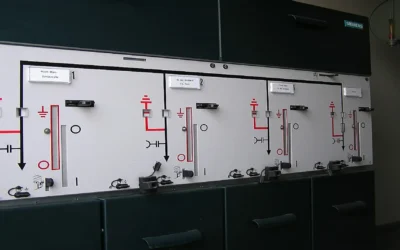• Realizing the GWP potential of SF6, the industry is shifting towards environmentally friendly alternatives.
• GIS is projected to exhibit robust growth with a CAGR of 7% in terms of revenue during the same period, with significant demand originating from renewable sources.
• SF6-free MV switchgear of the 1-24kV category, facing an earlier deadline in 2026, is anticipated to undergo the most rapid growth, with initial estimates suggesting CAGR surpassing 30% in terms of revenue during the same period.
Across Europe, gas-insulated switchgear (GIS) forms the backbone of a reliable and efficient electrical grid. However, GIS uses sulfur hexafluoride (SF6), a dangerous greenhouse gas that poses a significant threat to the environment. SF6 is one of the fluorinated gases (F-gases), and the EU is working actively to phase out the use of F-gases in Europe. The article sheds light on the deadlines for the SF6 phase-out and emerging MV switchgear market trends and outlook in Europe.

Figure 1: GWP Comparison of Some Gases.
Source: Greenhouse Gas Protocol.
Push for Alternatives
Realizing the GWP potential of SF6, the industry is shifting towards environmentally friendly alternatives. Under the European Green Deal, alternatives for SF6-based switchgear are urgently needed to meet the ambitious goal of a 55% greenhouse gas reduction by 2030. Balancing energy demands with environmental responsibility requires immediate action, making the search for sustainable solutions in the electrical switchgear sector paramount.
The EU has been at the forefront of acting against F-gases, enacting bans on their use in windows and tires since 2007. From March 2024, the revised F-gas Regulation (EU) 2024/573 has come into effect, reaffirming a steeper phase-out of F-gases from the remaining applications, building upon years of discussion and feedback from the stakeholders. For the electrical power grid industry, the deadlines for restriction on SF6-based switchgear are given below.
• Medium Voltage (MV) Primary and Secondary Switchgear <24kV: January 01, 2026
• MV Primary and Secondary Switchgear 24-52kV: January 01, 2030
• High Voltage (HV) Switchgear 52-145kV: January 01, 2028
• HV Switchgear >145kV: January 01, 2032
Effective after the deadline, the use of any f-gas in greenfield MV equipment is prohibited, as technically suitable alternatives with a GWP <1 will be available. For HV switchgear, the use of SF6 or other f-gas mixtures with a GWP > 1 will only be permitted if no OEM is offering a switchgear with an insulating medium of GWP < 1. Furthermore, starting from 2035, the use of new SF6 gas will be strictly prohibited, even for maintenance, and only reclaimed or recycled gas will be permissible. However, the regulations are lenient on brownfield projects where there are no technically suitable alternatives available. These stricter deadlines aim to accelerate the transition towards safer and more sustainable alternatives in the electrical industry.
MV Switchgear Market & Trends
According to projections by PTR, the MV switchgear market in Europe is anticipated to experience substantial growth in terms of revenue from 2023 to 2028. The air-insulated switchgear (AIS) is expected to achieve a CAGR of 4.75% in terms of revenue from 2023 to 2028, reflecting steady growth. Meanwhile, GIS is projected to exhibit robust growth with a CAGR of 7% in terms of revenue during the same period, with significant demand originating from renewable sources. The significance of GIS is evident from its major share, accounting for an estimated 60% of the total revenue in the switchgear market in 2028. As Europe experiences significant growth in MV Switchgear, particularly with the projected rise of GIS, the focus is on the emerging trends in SF6-free switchgear solutions, highlighting the industry’s commitment to sustainability and advancing eco-friendly alternatives.

Figure 2: Europe’s MV AIS/GIS Share and CAGR in Terms of Revenue from 2023-2028.
Source: PTR Inc.
Focus on SF6-Free MV Switchgear
PTR’s initial figures indicate a promising outlook for SF6-free MV switchgear, particularly those based on natural-origin gas, with a notable CAGR projected between 2023 and 2028. SF6-free MV switchgear of 1-24kV category, facing an earlier deadline in 2026, is anticipated to undergo the most rapid growth, with initial estimates suggesting CAGR surpassing 30% in terms of revenue from 2023 to 2028. In contrast, SF6-free MV switchgear of 24-42kV category, with a more distant deadline in 2030, is expected to experience growth at a comparatively lower rate.

Figure 3: CAGR for SF6-free 1-24kV MV Transformer in Terms of Revenue from 2023-2028.
Source: PTR Inc.
Way Forward
For OEMs in the MV switchgear industry, Europe’s commitment to sustainability signifies an exciting opportunity to spearhead the development and adoption of sustainable switchgear alternatives. The phaseout of SF6-based switchgear is gradual, however it is important to transition completely to SF6-free technologies to prioritize the environment. By harnessing innovation, fostering collaboration, and embracing cutting-edge SF6-free technologies, OEMs can not only comply with revised regulations but also secure a leading position in a greener future for the electrical industry.
Medium Voltage Switchgear Service Overview
The research presented in this article is from PTR's Medium Voltage Switchgear market research. For information about this service please submit a request shown below.
Europe: +49-89-12250950
Americas: +1 408-604-0522
Japan: +81-80-7808-1378
GCC/Rest of APAC: +971-58-1602441
More About our: Medium Voltage Switchgear Market Analysis
Recent Insights
COP through the Ages
This infographic takes a cursory glance at the most significant achievements of the Conference of Parties through the years and offers a chance for introspection on whether these pacts and declarations added any value in the bigger pictureContact Sales:...
Eyes on the Automobile Sector: Companies with Net-Zero Goals
In the wake of burgeoning climate threats, it is becoming ever-important to keep a track of how companies are making progress. Using data from Science Based Targets, this infographic displays the world's automobile companies that have a declared a net-zero target, and...
Eyes on the Automobile Sector: Companies with Near-Term Goals of 1.5-degrees
In the wake of burgeoning climate threats, it is becoming ever-important to keep a track of how companies are making progress. Using data from Science Based Targets, this infographic displays the world's automobile companies that have a declared a near-term target of...
The Energy Agenda at COP28
The themes at this year’s UN Conference of Parties- COP28- range all the way from Accountability to Urbanization and Built Environment. The agenda for the Energy theme will be addressed between 1st-5th December. COP28 emerges as a pivotal platform facilitating...
COP28: Climate Concerns to Address in 2023
From flash flooding to heat waves, each progressing year is a reminder that climate change is no longer a threat that looms on the horizon, but rather a reality that countries are- often disproportionately- dealing with. Climate change flurrying out of control only...
Riding the Wind: Fueling MV Switchgear Growth with Aggressive Energy Targets
A set of European countries are moving to deploy offshore wind farms in the North Sea which is expected to drive the demand for medium-voltage switchgear in the EU. This infographic sheds light on recent developments that have accelerated the shift towards renewable...
COP28’s Global Stocktake: A Pivotal Undertaking?
The global stocktake, a quinquennial undertaking, functions as a meticulous inventory of worldwide initiatives in climate action and support, with its inaugural culmination slated for COP28 in a bid to influence the ensuing round of nationally determined contributions...







